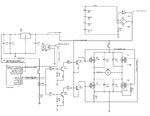JordanElektronika
Junior Member level 2
Good day to everyone! I have this circuit that I made, I simulated it with Proteus and everything seems to work fine, until I press the button to power the "H-bridge" and motor part. From 12V the voltage drops to 0.7V and everything stops. I want to ask why does that happen?
Proteus gives me 700A consumption for the motor, when it should be 200mA max. I think this is the mistake, But even if I put a DC source or the batteries, I get the same. Does anyone see another reason for this schematic not to work?

Proteus gives me 700A consumption for the motor, when it should be 200mA max. I think this is the mistake, But even if I put a DC source or the batteries, I get the same. Does anyone see another reason for this schematic not to work?
